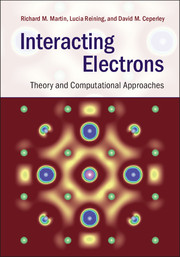Book contents
- Frontmatter
- Dedication
- Contents
- Preface
- Acknowledgments
- Notation
- Part I Interacting electrons: beyond the independent-particle picture
- Part II Foundations of theory for many-body systems
- 4 Mean fields and auxiliary systems
- 5 Correlation functions
- 6 Many-body wavefunctions
- 7 Particles and quasi-particles
- 8 Functionals in many-particle physics
- Part III Many-body Green's function methods
- Part IV Stochastic methods
- Part V Appendices
- References
- Index
5 - Correlation functions
from Part II - Foundations of theory for many-body systems
Published online by Cambridge University Press: 05 June 2016
- Frontmatter
- Dedication
- Contents
- Preface
- Acknowledgments
- Notation
- Part I Interacting electrons: beyond the independent-particle picture
- Part II Foundations of theory for many-body systems
- 4 Mean fields and auxiliary systems
- 5 Correlation functions
- 6 Many-body wavefunctions
- 7 Particles and quasi-particles
- 8 Functionals in many-particle physics
- Part III Many-body Green's function methods
- Part IV Stochastic methods
- Part V Appendices
- References
- Index
Summary
Preparation, I have often said, is rightly two-thirds of any venture.
Amelia EarhartSummary
Correlation functions provide a direct way to characterize and analyze many-body systems, both theoretically and experimentally. In this chapter we review the properties of one- and two-body correlation functions in quantum systems, with emphasis on several key quantities: static density correlations that determine the energy and thermodynamic potentials, dynamic correlation functions such as response functions that describe excitations of the system, and Green's functions that are basic tools in the theory of interacting many-body systems.
Correlation functions are central quantities in the description of interacting many-body systems, both in the theoretical formulation and in the analysis of experiments. In contrast to single numbers like the total energy, correlation functions reveal far more information about the electrons, how they arrange themselves, and the spectra of their excitations. In contrast to the many-body wavefunctions that contain all the information on the system, correlation functions extract the information most directly relevant to experimentally measurable properties. Dynamic current–current correlation functions are sufficient to determine the electrical and optical properties: one-body Green's functions describe the spectra of excitations when one electron is added to or removed from the system, static and dynamic correlations are measured using scattering techniques, and so forth. In this chapter we present the basic definitions and properties of correlation functions and Green's functions that are the basis for much of the developments in the following chapters.
In general, a correlation function quantifies the correlation between two or more quantities at different points in space r, time t, or spin σ. Very often the correlation function can be specified as a function of the Fourier-transformed variables, momentum (wavevector) k, and frequency ω. It is useful to distinguish between a dynamic correlation function which describes the correlation between events at different times and a static or equal-time correlation function, by which we mean that of a property measured or computed with “snapshots” of the system. Also, the different correlation functions can be classified by the number of particles and/or fields involved.
- Type
- Chapter
- Information
- Interacting ElectronsTheory and Computational Approaches, pp. 84 - 121Publisher: Cambridge University PressPrint publication year: 2016



